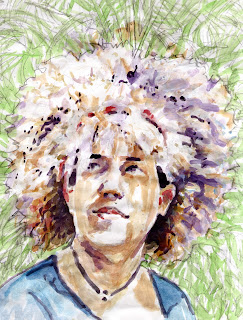 | |
| Efé group (after a photo by Hallet), 8.5" x 11", ink, 2013 |
Ethnic groups of the rainforests in central Africa include the Baka, BaAka, Ba-Benjelle, Bambinga, Mbuti, Efé, Bedzan, Bibayak. Examples of music from all of these peoples have been included in one or more of my annual lists of 100 songs. The rainforest peoples once were known by their derogatory name pygmies. Their music, and especially the polyphonic singing style, has become known throughout the world as a remarkable synthesis of human and nature. Their traditions are rapidly becoming extinct and so is the practice of their music. I've gathered quite a collection of sound recordings that feature the music of these people of central Africa and was delighted to find, at a thrift store of all places, a record with some very early recordings. Featured on the LP The Belgium Congo Records are recordings made
during the 1935-36 Africa expeditions to the Congo by Armand Denis and
Leila Roosevelt. On it are very early, but not the earliest, recordings
of Pygmy music. My favorite track on the album is a recording by a Pigmy orchestra of
Kigali, (Rwanda) which is ironically filed under the heading of Royal Watusi Drums. (The Watusis–Tutsis as they are now called, are considered to be tallest race in Africa, Pymies being the shortest.) Not long after I found the LP, I came across a recording of the Efé made in the northern Belgian Congo by Armand Hutereau between 1909 and 1912, one of the earliest to exist. The two recordings mentioned, come in at #62 and #63 in the Top 100 of 2012.
 |
| Pygmy group (after a 1923 photograph)
11" x 8.5", watercolor on paper, 2013 |

















